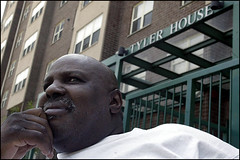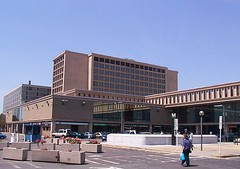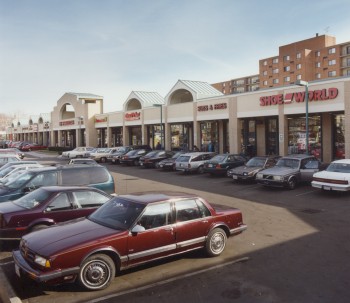"Gentrification" and HUD Section 8 subsidized multiunit housing in DC
Rob Goodspeed has an interesting blog entry on HUD-subsidized multiunit housing complexes in DC, how this has led to some neighborhoods "not gentrifying," how most of these buildings are in "mid-city" and Columbia Heights, and how many of the contracts are coming up for renewal. He constructed a map of every such building in the city, based on data from a HUD database.
He posits that the for-profit owned buildings will change to market-rate housing, but that the non-profit owned buildings probably will not. He suggests that buildings in the latter group, many of which (at least along 7th Street NW) are under-dense, could be redeveloped as mixed-use denser projects, allowing for neighborhood improvement without displacement.
 Photo: Kevin Clark, The Washington Post. Caption: Jim Brown, 60, is president of the tenants association at the Tyler House which is targeted for redevelopment under the mayor's New Communities initiative.
Photo: Kevin Clark, The Washington Post. Caption: Jim Brown, 60, is president of the tenants association at the Tyler House which is targeted for redevelopment under the mayor's New Communities initiative.Given that most nonprofit housing organizations in the city aren't that entrepreneurial or forward-thinking, especially when it comes to quality in design and project, I wouldn't hold my breath. It's an interesting idea however.
It would be another area where the City Government could step up, like the New Communities program, which is a local version of the arguably successful federal HOPE VI program, which has rebuilt public housing projects into mixed income developments.
But generally the City Government "isn't all that" either when it comes to quality in design and making hard choices. Plus there isn't a good track record in the city for quality. Post-riot urban renewal inserted an incredible quantity of lousy buildings and bad design into the city--not that pre-riot urban renewal in Southwest DC was that much better.
 Pre-riot urban renewal. Waterfront Mall, Southwest DC. Photo from BeyondDC.
Pre-riot urban renewal. Waterfront Mall, Southwest DC. Photo from BeyondDC. Post-riot urban renewal. H Street Connection. Capitol Hill Towers, a senior housing buidling that is on the list of buildings receiving HUD Section 8 Support, is in the background of this photo.
Post-riot urban renewal. H Street Connection. Capitol Hill Towers, a senior housing buidling that is on the list of buildings receiving HUD Section 8 Support, is in the background of this photo. It's a miracle that the city has survived all its urban renewal plans and has had enough historic building stock and interesting places to attract a new generation of people interested in urban living.
Thank historic preservation. Not the hundreds of millions of dollars spent on various urban renewal efforts from the mid-1970s until oh say 2005.
The renewed demand in the city today results from a marginal increase in demand for urban living (in part this is due to the costs of commuting, I joke that it also results from the tv show Friends, which showed urban living in a fine light, maybe in part it was Jennifer Anniston's hair), location, historic residential building stock, and great transit assets (not to mention the steady job engine of the federal government). Not HUD or DC's Department of Housing and Community Development.

Index Keywords: housing



0 Comments:
Post a Comment
<< Home